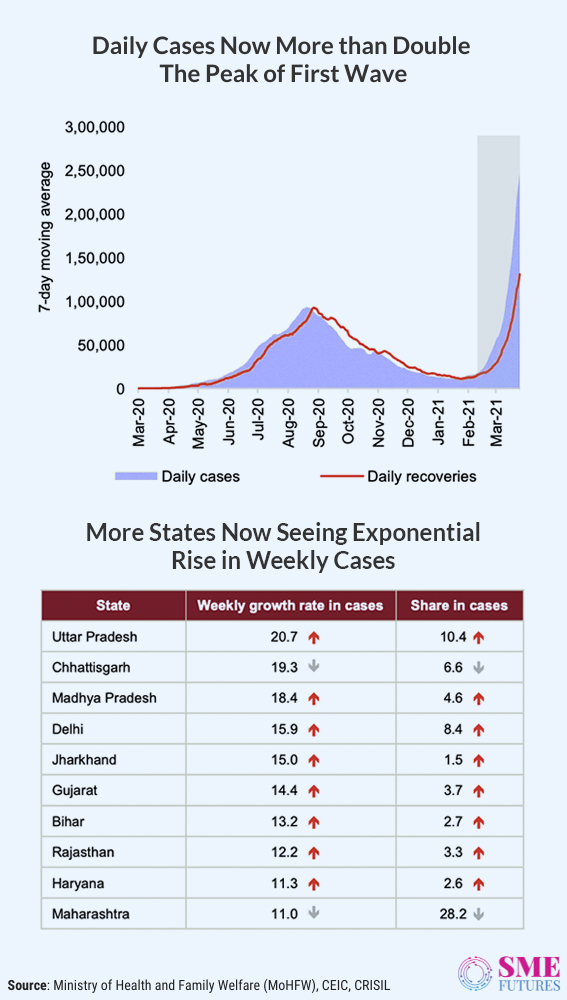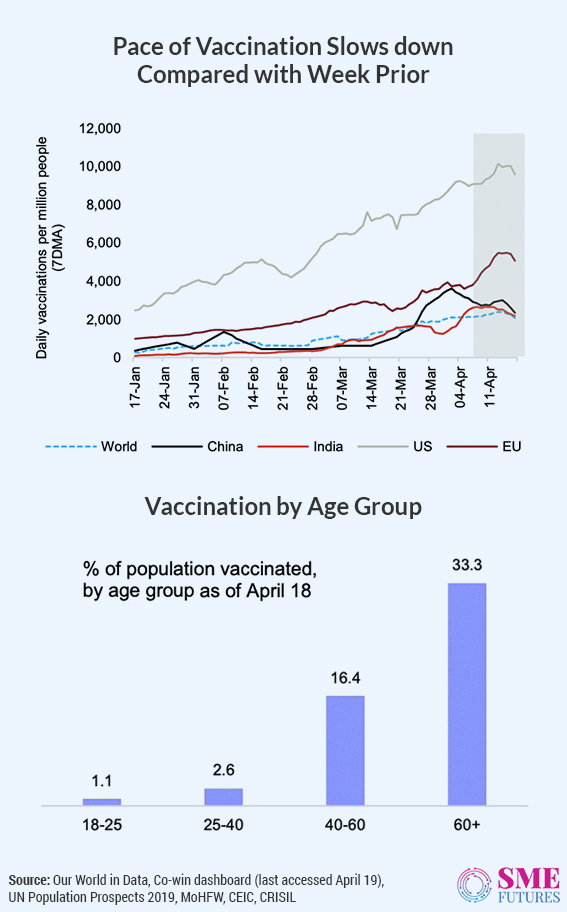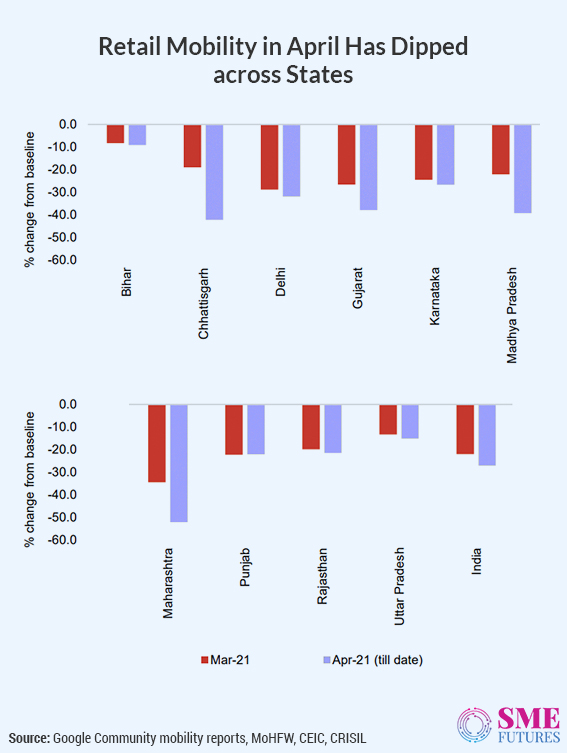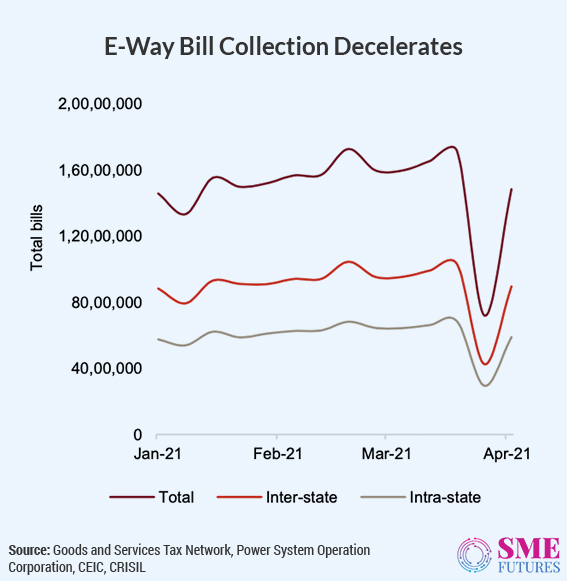Globally, the 2nd wave of COVID-19 has been much higher in intensity than the first wave was, and India is no exception. The new infection cases have already superseded last year’s numbers and the death count has gone as high as 1,700+ a day. And the plight of the people dealing with an overburdened healthcare system cannot be described in words. Given the rapid rise in infections, there is an increased demand for vaccines. Sporadic lockdowns, strict guidelines and restrictions have also re-emerged across many states. More than 3 out of every 10 cases reported globally each day are from India.

Indeed, it is a challenging time for India, not only due to the virus but the flailing economy is making things worse as well.
What needs to be seen now is how these mini-lockdowns and restrictions are going to impact our economic recovery, which we all thought was on its way to recovery.
Earlier, India Inc along with the experts and economists had predicted a V-shaped recovery curve for the Indian economy but that seems almost unachievable now. As per the COVID trends, it is unlikely that the GDP will grow any further. Therefore, the economists are making downward revisions whilst predicting a degrowth for the economy.
“To give you a general view, it appears that the second wave has rolled back the growth prospects for FY22 and is expected to derail the nascent recovery witnessed during Q4, FY21,”
says Dr. Arun Singh, Chief Economist at Dun & Bradstreet.
“The estimate for GDP growth during FY22 has already been revised downwards from the expectation of lower double-digit growth to higher single digit growth. The risk from high global commodity prices, rise in asset quality stress in the banking system and debt further add to the downside risks to growth,” he further states.
Last year, by June 2020, India’s GDP was down by 24.4 per cent. But as per the NSO’s second advance estimates, India’s real GDP during 2020-21 is estimated to contract by 8 per cent.
However, in its recent monetary policy meeting, RBI forecast the projection of real GDP to be retained at 10.5 per cent for 2021-22. Breaking out with a quarterly path of 26.2 per cent in Q1, 8.3 per cent in Q2, 5.4 per cent in Q3, and 6.2 per cent in Q4 – with the risks evenly balanced.
But with businesses hurting just as much due to the freshly imposed sporadic lockdowns, there might be further revisions to the GDP. This can further have a cascading effect on economic recovery assuming a disarray in demand and supply.
Demotivating days
As PM Modi said in his address to the nation—the second wave of the coronavirus has hit us like a storm.
To begin with, the pressure on the public health infrastructure and household healthcare expenses has significantly mounted.
Demotivating as that already is, both future expectations and consumer confidence have taken a plunge.
The consumer confidence index fell to 53.1 in March 2021 from 55.5 in January 2021, the RBI survey released recently showed. “Consumer confidence for the current period weakened in March as the current situation index dipped further in negative territory on the back of deteriorating sentiments on the general economic situation, income and prices,” said the survey.
The public’s low optimism for the year ahead against the current scenario is reflected in the future expectations index (FEI); which is at 108.8 from 117.1 earlier. This further points to higher spending in the future.
Dr. Singh opines, “The restrictions on people’s movement is likely to generate hoarding tendencies and fuel inflationary pressures. In times of uncertainty, the various services costs are expected to flare up, including that of logistics. Supply side pressures to inflation also emanates from the elevated international commodity prices and increase in liquidity in the banking system as RBI injects one trillion rupees through the G-Sec Acquisition Programme (G-SAP). However, lower demand for non-essential and recreational services and better agricultural output in the coming months should offset some of the price pressures.”
Already, the rising Covid cases and the various restrictions have started having a negative impact on the market and the different sectors.
Retail is the first to feel the blow
Partial lockdowns, local restrictions, closure of malls and department stores in a few states have started to have an adverse impact on the retail businesses. Weekend curfews have further halted the sectoral recovery.

Malls across India had recovered close to 90 per cent of their business and 75 per cent of their footfalls, but that has dropped drastically due to the restrictions. Whereas the retail and wholesale businesses have taken a hit of Rs 46,000 crore in the first week of April.
As per the Shopping Centres Association of India (SCAI), the industry which supports 1.2 crore livelihoods, got back to pre-covid levels in March—Rs 15,000 crore per month, but due to the rapidly rising cases, almost 50 per cent of their revenue has been slashed.
Likewise, the Confederation of All India Traders (CAIT) states that retail businesses have taken a hit of Rs 32,000 crore, while wholesale businesses have suffered a loss of Rs 14,000 crore. Nearly 60 per cent of consumers are now avoiding visits to the markets due to the threat of contamination.
The hospitality and tourism industry too are grappling with the second wave
Things were just starting to look up for them, but Covid has once again put a damper on that.
The hospitality sector which suffered massively due to the pandemic last year, is once again under tremendous stress. For restaurants and hotels, things are getting worse too due to the resurgence of Covid across the country.
As per the experts, among all the core sectors, hospitality was the first one to fall and the last one to recover, as it was one of the last sectors to be re-opened. The industry had lost all its business after the lockdown came into effect and the zero-business scenario remained for close to 10 months last year. However, obligations such as rental and salary expenses, servicing of debts and statutory payments remained as well. Several establishments across Maharashtra, Gujarat, Punjab and Tamil Nadu reopened as late as October of 2020.
“This has led to mounting debts, threats of insolvency for a majority in the sector along with millions of job losses. As of today, 30 per cent of hotels and restaurants in the country have shut down permanently due to financial losses. Over 20 per cent of hotels and restaurants have not opened fully after the lockdown. The remaining 50 per cent continue to run in losses and revenues are below 50 per cent of the pre-COVID levels,”
says Gurbaxsh Singh Kohli, Vice President, FHRAI.
The hospitality industry is one of the major contributors to the nation’s GDP and its earnings were hugely impacted due to COVID-19. Tourism and hospitality accounted for around 10 per cent of the GDP, supported around 90 million jobs and generated Foreign Exchange Earnings (FEE) to the tune of Rs.1,94,881 crores (US$ 29.96 billion) in 2019. According to him, there is no respite for the hospitality sector, despite it maintaining high quality and following all SoPs.
Similarly, the travel and tourism sectors are in the doldrums too.
The recent update is that India is now on the travel ban list of many countries, including the US, the UK, New Zealand and Hong Kong.
The continuous surge in Covid infections and the partial travel restrictions may also lead to a halt on inbound travel, resulting in further losses for the businesses in this field. Just to be safe, businesses have urged the government to extend the scope of air bubble arrangements to include the movement of India-destined leisure travellers. The Indian Association of Tour Operators (IATO) feels this will help the industry to get some overseas tourist traffic.
In its submission, the IATO suggests that the government should resume international flights, at least for those who are fully vaccinated. “Countries are opening up for travel for those fully vaccinated and India can adopt the same model,” it said. The document also suggests drawing up a timetable as per which the dates for opening visas, including e-visas, and resumption of international flights can be announced. Such a move will allow the Indian tour operators to touch base with their counterparts abroad in advance and bookings could be made likewise.
Last year, during this same period, the revenues for the travel and tourism industry almost dropped to zero.
Could the second wave spell ruin for the manufacturing industry?
Over the past few months, the manufacturing sector had been reclaiming what was lost. But now, its fate seems uncertain due to the impact of the second wave. The partial lockdowns and restrictions, if aggravated, can disrupt the manufacturing ecosystem once again.
And early signs of that have already started to emerge.
India’s manufacturing activity has already plummeted to a seven-month low of 55.4 in March 2021 from 57.5 in February, states the India Manufacturing Purchasing Managers’ Index (PMI) released by IHS Markit. As per Pollyanna De Lima, Economics Associate Director at IHS Markit, after starting 2021 on a stronger footing than it was on at the end of 2020, the manufacturing sector has lost further growth momentum in March. Production, new orders and input buying are expanding at softer rates.
“The survey participants indicated that the demand growth was constrained by the escalation of the Covid-19 pandemic, while the rise in input buying was curtailed by an intensification of cost pressures,” Lima said.
The Indian manufacturing sector is one of the key economic contributors with a share of 15 per cent in the GDP and is one of the largest employers, giving jobs to millions of formal and informal workers. However, with the reimposition of the lockdowns and restrictions, Indian manufacturers are staring at challenging times ahead.
Ankit Agrawal, Director & Partner at Mysore Deep Perfumery house, Zed Black brand, feels the same. According to him, the industry is still coping with the negative effects of the COVID 19 lockdown, 2020. And a second wave of Covid will only exacerbate the situation.
“This is a very unusual situation. The second wave is going to worsen the situation even more and it will affect not just the economy but everyone else too. People’s sentiments are negative, and labourers are again migrating from states like Maharashtra, even though a full lockdown has not been announced yet. The second wave is hitting even more people than last year, which is taking a toll on the healthcare system and the psyche of people as well. Overall, morale is low, we are still trying to find a way to recover from the first lockdown and this second wave is going to hit us in the worst way possible, “he reiterates.
Supply chain disruption, raw material procurement and availability, high commodity prices and low demand for products are some of the issues that the manufacturing industry is facing currently, and this can really hurt this segment.

“There is overall instability due to soaring prices and the non-availability of raw material due to scarcity, while on the other hand, the demand for the finished product is low. The supply chain is disrupted, especially on imports and exports as availability of shipping containers is one of the major issues. The prices of shipping containers have gone up, e.g. A 40 ft container to New York, which costs $1600, is costing $6000 (price still increasing every 15 days) post COVID 19. Despite the hike in charges, container bookings are not confirmed, and trans-shipment ports are congested. These things need to be addressed and resolved as early as possible, ” says Agrawal.
The real estate sector is also dealing with the impact
The resurgence in Covid-19 cases has slowed down the construction and sales activity across the entire real estate sector.
Ashok Mohanani, President, NAREDCO Maharashtra says, ”The current lockdown has already proved to be a damper of the festive spirit, as we have witnessed muted sales on the occasion of Gudi Padwa. It would be difficult to sustain the demand if adequate government support is not provided to the developers.”
Adding to that, Pritam Chivukula, Co-Founder & Director, Tridhaatu Realty and Hon. Secretary, CREDAI-MCHI says, “The new curbs won’t affect the large and medium-sized developers as they are already taking the necessary precautions at the sites. Although this will affect the small developers and the redevelopment projects as they do not have enough space for labour camps. The permission to transport labourers from labour camps to construction sites, while adhering to safety guidelines will help the smaller developers to complete and deliver their projects on time and thus sustain the demand.”
Digital solutions will spike up
Paranoia, fear of contagion and anxiousness due to the raging viral infection has resulted in desperation and depression for many. With an unprecedented spike in the virus cases in the last few weeks, the nation is grappling with a myriad of healthcare issues.
However, various digital health solutions are here to help and are certain to witness a spike in traffic and usage on their portals. According to Dr. Harshit Jain, Founder & Global CEO at Doceree, a physician only marketing platform, pharma digital marketing will experience a rise in situations where sales representatives cannot have access to physicians.
“When the virus outbreak had happened, pharma marketers turned to digital technologies to engage physicians. With the span of covid restrictions extending in the event of the second wave, we will witness a huge inclination among pharma brands towards digital mediums. At the moment, pharma marketers are using digital mediums for physician engagement at a very brand level and not at an enterprise level. So, the more time brands have with digital mediums to understand the value they offer for marketing purposes, the better would be the chances of pharma companies incorporating them at an enterprise level, “he says.
Currently, doctors and healthcare workers are overwhelmed, and facilities are running low with a shortage of beds and oxygen supplies but with many seeking to be admitted to these facilities. This is further compounded by the devastation and losses borne by the people as well as by the businesses.
An immunity drive for the economy and the people
The first wave of the corona virus took a heavy toll not just on people’s lives but on the Indian economy as well.
In the last few months, India was gradually getting back on track through government fiscal packages and various relief measures.
This time, there are more concerns compared to last year. According to Moody’s analysis, “The second wave of infections presents a risk to our growth forecast as the reimposition of virus management measures will curb economic activity and could dampen market and consumer sentiment.”
While, as per Nomura’s Asia Insights Global Market research, both the pandemic predicament and its effect on development will continue to evolve as a greater rise in instances is escalating public and private proclivities towards restricted mobility.
The crucial concern is when decreased mobility translates into decreased out-turns in other true financial development indicators.
However, the only positive factor out of all this is the vaccination drive, but its pace is stuttering. As of now this is a concern.

As per the CRISIL data, India’s average daily vaccination per million people in the week ending 18 April 2021 was 2,408, lower than the 2,554 per million in the previous week, indicating a slowdown in pace. As of 18th April, 16.4 per cent of the population in the age group of 40-60 were vaccinated, and among those aged 60+, a higher percentage of 33.1 per cent have been vaccinated.
India needs to pick up its pace to accomplish this gargantuan task.
As Dr. Singh suggests, “The keys to the revival of the economy are- pick-up in the vaccination rate, further stimulus measures and improvement in global growth.”











